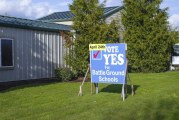A closer look at the arguments for voting no on the $224.9 million BGSD building bond
BATTLE GROUND — On April 24, residents within the Battle Ground School District will be asked once again to decide on whether to approve a $224.9 million construction bond.
The District has argued the money is needed for one new K-8 school, and to replace several buildings, largely in the southern portion of the district. They argue existing schools, such as the Glenwood/Laurin campus, and Pleasant Valley are already well beyond capacity, and more growth is projected over the next 10 years.
The district spent $15,000 last November to bring in E.D. Hovee & Company Economic and Development Services, to put together a student enrollment forecast. It showed that, as of last year, enrollment had not yet recovered to pre-recession levels. That, despite the fact the overall population in the district had grown by nearly 8,000 people during that same time period.

Battle Ground resident Dick Rylander has become one of the most familiar members of the opposition to the bond. Not, he says, because he doesn’t think overcrowding is a problem, but because he believes the district has overestimated what they need. The former adjunct professor at the University of Portland calls himself a numbers guy, and he’s spent considerable effort digging through the mounds of data the district has used to support the bond.
“The perception is that all of these homes that are being built either have, or will miraculously generate huge numbers of students,” Rylander tells Clark County Today, “and the numbers just aren’t there.”
The Hovee report estimated the district could add between 1,535 and 2,735 students over the next decade. That would bring the total headcount in the district to between 14,650 and 15,852. Those numbers were based on both past years, and the estimated number of new homes expected in Clark County over the next 10 years. Rylander says his own research reached a different conclusion.
“There is some growth, and it is on the southern end, I don’t disagree with that at all,” he adds, but “the numbers are not significantly huge. The northern portion of the district is actually seeing a decline.”
If you want to take a deeper dive into Rylander’s analysis of the numbers in the Hovee report, you can do that by clicking here.
One major factor he says the Hovee report is ignoring is the potential for another economic downturn. The current economic growth period is now a decade-old, and Rylander argues the odds of that continuing for another decade is incredibly slim. The report does acknowledge this fact, indicating their estimate is a 1.7-percent annual population growth in Clark County between now and 2027. With birth rates running well below estimates of a decade ago, the report anticipates each new household will represent 0.38 children for the district. That’s below the statewide average of 0.45 kids per household.
It’s a lot of numbers, but the upshot is that Rylander and those opposed to the bond believe the district is overstating its needs, and could have put a much less expensive construction plan in front of voters.
“Let me be really clear — I personally believe that they should replace Glenwood and Laurin,” he says. “I also (support) either a replacement of the Pleasant Valley Middle, or a remodel, whichever makes more economic sense.” He also supports some expansion at Prairie High School, where forecasts indicate student population growth is expected.
Where Rylander, and many opposed to the bond, believe the district has overreached is in the desire to build a new K-8 school on 152nd Ave. Other projects, such as covers over playground equipment at some schools, strike some as needlessly exorbitant.
“Oh my gosh,” Rylander says, laughing, “How did we ever survive with kids outside playing in the rain? I mean, sorry about that.”
He says some of the things the bond would cover are expenses that should be coming out of the $136.54 million Maintenance and Operations Levy narrowly approved by voters last year. One of those includes replacing the turf at Battle Ground’s District Stadium. Money to do that is in the levy, but would come out of the bond instead if voters approve it.
Therein lies probably the most strident argument you’ll hear against the bond — mismanagement of money. While the district is proud of its clean audits in recent years, some argue money from the levy is being misused for unnecessary staffing and programs, when it could be used to maintain existing buildings. While levy money can’t be used for building new schools, it can be used for upkeep and maintenance.
Battle Ground Superintendent Mark Ross says they gave the citizen advisory group ample space to suggest removing some projects from the bond before putting it back on the April ballot, but they suggested nothing should be eliminated.
Others question why the cost of the Bond went up from $80 million when it was first introduced in November of 2016, to $224.9 million this year. Numbers from the district indicate rising construction costs, inflation, and other factors drove the costs up to an estimated $409/sq ft for the Glenwood/Laurin replacement, and costs for future builds will likely go up from there. Some projects also increased in size, and the district decided to pursue more money up front to tackle a backlog of projects.
There’s also the argument over what property owners can expect their actual cost to be should the bond be approved. District officials maintain the cost will go down next year, as a new state law capping local levies takes effect, and the legislature’s recently passed one-year property tax relief goes into effect.

In a detailed spreadsheet, Rylander looked at the total tax burden for Battle Ground property owners. While his estimates agreed the tax burden on a $350,000 home would likely see a decrease of nearly $200 in 2019, that burden would then go up by around $420 the following year. That represents a $228 increase per year over current property taxes with the bond in effect. The district’s numbers also don’t take property value increases into account.
“They talk about tax rates either being flat or going down,” Rylander says, “and implying that your taxes will go down as well. But you can’t draw that distinction.”
The change the state legislature made may have capped local levies, but it also tied them to assessed value. That means that increasing property values could see rates paid rise more than anticipated. Rylander says his own property tax bill went up over $1,200 this year due to the legislature’s moves to fully fund education. It’s a fallout many in the county have noticed, and it’s why the district needs voters to buy into the idea that those tax rates will level out, so they bond won’t be felt quite as much as they might otherwise think.
Rylander is quick to say he’s not against funding schools. As he puts it, they put four children through school, and have 11 grandkids with a great-grandchild on the way.
“I’m not against doing stuff,” he says, “I am against doing stuff that’s not necessary, and not using your maintenance and operations fund properly.”
Should voters decide to reject the bond yet again, the district could not reintroduce it until next year. Rylander says he’d advised the board to try again next August.
“And here’s why,” he told the board, “low turnout helps the ‘yes,’ high turnout helps the ‘no.’ In August, the people who want this are absolutely going to vote ‘yes,’ but it will be the dog days of Summer, people will be on vacation and it might not get much notice from the ‘nos.’ and the chances of passing it will go up.”
The board decided against that, citing the immediate need to get started on the projects, and the potential for rising costs in the current construction environment. They will find out April 24 if their gamble pays off.
Dick’s page: http://www.swweducation.org/?cat=1528
District’s page: http://www.battlegroundps.org/bond
Also read:
Battle Ground Schools building bond: Part I — The arguments in favor





